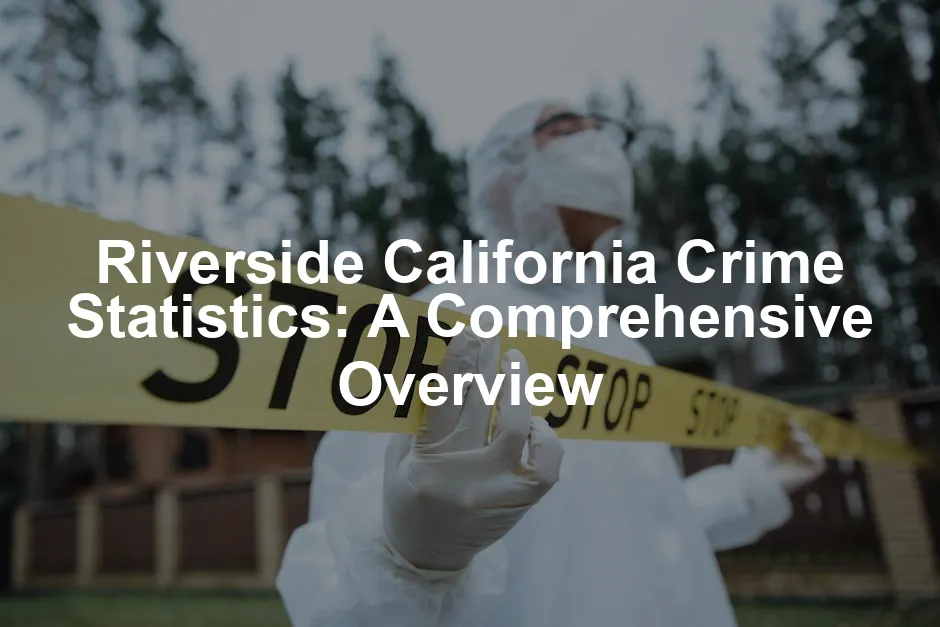Introduction
Riverside, California, is not just another city in the Golden State; it’s a vibrant community with a rich history, diverse population, and a unique charm that attracts residents and visitors alike. Nestled in the heart of the Inland Empire, Riverside boasts a population of over 330,000 people. This city is known for its stunning historic landmarks, such as the Mission Inn, and its lush, green parks. Riverside also serves as a hub for education, home to the University of California, Riverside, which offers a bustling campus life.
Understanding the crime statistics of Riverside is crucial for various stakeholders, including current residents, potential homebuyers, and policymakers. This article aims to provide an in-depth analysis of crime in Riverside, comparing its statistics to both state and national averages. By dissecting the data, we can gain valuable insights into the safety and security of this community.
For residents, knowing the crime landscape can lead to enhanced safety measures and community involvement. Prospective homebuyers can make informed decisions about where to settle down based on crime rates. Policymakers can utilize this information to develop effective strategies for crime reduction and community safety initiatives. Overall, a comprehensive understanding of Riverside’s crime statistics empowers everyone to contribute to the city’s well-being.

Understanding Riverside’s Crime Landscape
Overview of Crime in Riverside
Riverside has a reputation for having a notably high crime rate. The total number of reported crimes stands at a staggering 12,585, which translates to a crime rate of 39.23 incidents per 1,000 residents. To put this into perspective, your chances of being a victim of crime in Riverside are approximately one in 25. This alarming figure places Riverside among the cities with the highest crime rates in the nation. In fact, over 92% of communities in California report lower crime rates than Riverside.
When comparing Riverside to other California cities, it’s essential to note that its crime rates are significantly higher than the state average. This can raise concerns among residents and prospective buyers about the overall safety of the area. For a comprehensive analysis of crime statistics in Fremont, which can provide further context, see Fremont Crime Statistics.
Understanding crime statistics is vital for residents and policymakers alike. Fremont crime statistics can offer valuable insights into similar issues faced by other communities.
Types of Crimes
Violent Crimes
Violent crimes, which include offenses like murder, rape, robbery, and assault, are a pressing concern in Riverside. The city recorded a total of 1,664 violent crimes, resulting in a violent crime rate of 5.19 per 1,000 residents. To break it down further, Riverside had 18 murders, 141 rapes, 435 robberies, and a staggering 1,070 assaults. These statistics paint a concerning picture of the safety of individuals living in the city.
Given the rising concerns about personal safety, investing in a Personal Safety Alarm might just be the best decision you make. This handy device can be a lifesaver, providing a loud sound to deter potential threats and alert others nearby. Carry it with you wherever you go, and feel a little safer knowing you have a backup plan!

Property Crimes
Property crimes, encompassing burglary, theft, and motor vehicle theft, are also prevalent in Riverside. With a total of 10,921 reported property crimes, the property crime rate reaches 34.05 per 1,000 residents. This includes 1,633 burglaries, 7,473 incidents of larceny, and 1,815 motor vehicle thefts. Such high numbers indicate a significant risk for property owners and renters alike, making vigilance essential for residents.
To protect your home from potential break-ins, consider installing a Home Security Camera System. Not only can these cameras monitor your property 24/7, but they can also provide peace of mind knowing that you have a record of any suspicious activity. It’s like having a security guard, but without the need for snacks and coffee breaks!
In summary, Riverside’s crime landscape reveals a city grappling with significant challenges in both violent and property crimes. Understanding these statistics is vital for anyone living in or considering moving to this dynamic city.

Crime Trends and Historical Data
Year-over-Year Crime Analysis
The crime landscape in Riverside, California, has witnessed notable fluctuations over the years. Below is a table illustrating the year-over-year crime rates from 2010 to 2022.
| Year | Total Crimes | Violent Crimes | Property Crimes |
|---|---|---|---|
| 2010 | 11,709 | 1,360 | 10,349 |
| 2011 | 11,307 | 1,420 | 9,887 |
| 2012 | 11,860 | 1,450 | 10,410 |
| 2013 | 12,300 | 1,500 | 10,800 |
| 2014 | 12,080 | 1,420 | 10,660 |
| 2015 | 12,450 | 1,550 | 10,900 |
| 2016 | 12,911 | 1,600 | 11,311 |
| 2017 | 12,500 | 1,650 | 10,850 |
| 2018 | 12,600 | 1,700 | 10,900 |
| 2019 | 12,250 | 1,600 | 10,650 |
| 2020 | 12,800 | 1,750 | 11,050 |
| 2021 | 13,058 | 1,800 | 11,258 |
| 2022 | 12,585 | 1,664 | 10,921 |
Riverside experienced a peak in both violent and property crime rates in 2021, with 13,058 total crimes reported. However, in 2022, the overall crime rate decreased slightly to 12,585 incidents. This decline may provide some relief to residents, although the city still grapples with a high crime rate compared to national averages.
When analyzing the data, we observe a trend of increasing violent crimes, particularly from 2010 to 2021. The most significant spike occurred between 2019 and 2020, raising concerns about community safety. Conversely, property crimes have shown fluctuations but maintained a relatively consistent level, averaging around 10,900 incidents.

Longitudinal Study of Crime Rates
A longer-term perspective, spanning from 1999 to 2018, reveals deeper insights into Riverside’s crime rates. The following chart summarizes the violent crime rates per 100,000 residents over nearly two decades.
| Year | Violent Crimes (per 100,000) |
|---|---|
| 1999 | 627.18 |
| 2000 | 621.56 |
| 2001 | 615.21 |
| 2002 | 595.36 |
| 2003 | 579.63 |
| 2004 | 527.80 |
| 2005 | 526.02 |
| 2006 | 533.45 |
| 2007 | 524.06 |
| 2008 | 504.21 |
| 2009 | 473.29 |
| 2010 | 439.58 |
| 2011 | 411.16 |
| 2012 | 423.54 |
| 2013 | 402.64 |
| 2014 | 396.38 |
| 2015 | 427.97 |
| 2016 | 444.81 |
| 2017 | 453.30 |
| 2018 | 447.41 |
This longitudinal analysis indicates that Riverside’s violent crime rates peaked in the early 2000s before gradually declining until around 2014. Since then, there’s been a noticeable uptick in violent crime, suggesting that public safety remains a pressing concern.
The implications of these trends are significant for community safety and law enforcement strategies. Increased awareness and proactive measures are necessary to address the persistent issues of crime in Riverside. This data underscores the importance of continuing to monitor crime trends and engage the community in safety initiatives.

Comparative Analysis
Riverside vs. State and National Averages
When comparing Riverside’s crime rates with California and national averages, the discrepancies become evident.
- Violent Crime Rate: Riverside (28.7), California (22.7)
- Property Crime Rate: Riverside (46.7), California (35.4)
Riverside’s violent crime rate is notably higher than the California average, indicating a significant challenge for local law enforcement. In terms of property crime, the city also exceeds state averages, further emphasizing the need for strategic crime reduction efforts.

Crime Comparison with Other Cities
To provide context, here’s how Riverside’s crime statistics stack up against similar-sized cities.
| City | Violent Crime Rate (per 100k) | Property Crime Rate (per 100k) |
|---|---|---|
| Riverside | 28.7 | 46.7 |
| Corona | 24.5 | 38.1 |
| Moreno Valley | 25.3 | 32.4 |
| San Bernardino | 31.4 | 48.9 |
Riverside’s crime rates are comparable to its neighbors, with slightly higher numbers than Corona and Moreno Valley but lower than San Bernardino. This comparative analysis highlights the crime challenges faced across the region, suggesting that collaborative efforts among these cities could foster more effective crime prevention strategies.
Overall, understanding Riverside’s crime statistics in relation to surrounding cities and state averages is essential for residents and policymakers alike. By acknowledging these patterns, stakeholders can work together to enhance safety and security in the community.

Neighborhood Analysis
Crime by Neighborhood
Riverside is a city of diverse neighborhoods, each with its own charm and crime rates. Some popular areas include Hillcrest, Alessandro Heights, and Canyon Crest. Unfortunately, not all neighborhoods are created equal when it comes to safety.
For instance, Hillcrest is often regarded as one of the safer neighborhoods, boasting community initiatives that foster a sense of security. In contrast, areas like Downtown Riverside and Eastside present higher crime rates. According to recent statistics, neighborhoods closer to the downtown core have a crime rate of 48 incidents per 1,000 residents, whereas Hillcrest enjoys a much lower rate of just 22 incidents per 1,000 residents.
Alessandro Heights is another neighborhood worth mentioning. It has a crime rate that falls below the city average, making it a popular choice for families and young professionals. However, the Eastside, with a higher concentration of crime, tends to raise eyebrows among potential homebuyers and families.
Understanding the crime rates by neighborhood can help residents make informed decisions. Whether you prioritize safety or community engagement, knowing which areas are safer can steer you in the right direction.

Community Perspectives on Safety
The sentiment about safety in Riverside is a mixed bag, as shown by surveys conducted in the city. According to an AreaVibes poll, 34% of residents feel that crime is a minimal issue, while 66% believe it is a significant concern. This stark contrast highlights the diversity of experiences among residents.
“I feel safe walking in my neighborhood during the day, but I wouldn’t go out at night,” says Sarah, a longtime Riverside resident. Her perspective echoes what many feel; the city has its safe pockets, but caution is a must in others.
Another resident, Mike, expressed a different view: “I’ve lived here for years, and the crime has definitely increased. I used to feel safe, but now I keep my doors locked and stay alert.” His words resonate with the growing unease many feel, particularly in areas with higher crime rates.
These testimonials reflect a broader sentiment in Riverside. While some residents find peace in their neighborhoods, others are increasingly vigilant about their safety. Understanding these perspectives is crucial for anyone considering a move to the city.

Crime Prevention and Law Enforcement
Overview of Law Enforcement in Riverside
Riverside’s police force is significantly smaller than the state average, with only 1.09 officers per 1,000 residents compared to California’s average of 2.30. This discrepancy raises questions about the effectiveness of law enforcement in addressing crime.
Despite this, Riverside has implemented several community policing initiatives aimed at building trust between the police and residents. Programs such as neighborhood watch and community forums allow citizens to engage with law enforcement proactively. These initiatives are vital for fostering a collaborative environment where residents feel empowered to report crime and assist in their community’s safety.
To enhance safety, consider investing in a Smart Door Lock. This advanced technology not only allows you to lock and unlock your door remotely but also provides added security features such as temporary access codes for guests. Say goodbye to fumbling with keys and hello to modern convenience!

Strategies for Improving Safety
To enhance safety in Riverside, several strategies could be beneficial. First, increasing the number of officers per capita would ensure quicker responses to incidents and a more visible law enforcement presence. This would instill confidence among residents.
Another approach could involve expanding community programs that promote neighborhood engagement. Activities such as block parties or community clean-up events can foster camaraderie and encourage neighbors to look out for each other.
Investing in youth programs is also crucial. Providing safe spaces for teenagers and young adults can deter them from engaging in criminal activities. When communities invest in their youth, they invest in their future.
Ultimately, a comprehensive approach that combines increased law enforcement presence with community engagement can significantly reduce crime rates in Riverside. This multifaceted strategy is essential for creating a safer environment for all residents.

Conclusion
In summary, Riverside, California, faces significant challenges concerning crime rates. The statistics reveal a high prevalence of both violent and property crimes, with the city’s total crime rate standing at 39.23 incidents per 1,000 residents. This alarming figure underscores the importance of community awareness and the need for residents to actively engage in crime prevention initiatives.
Community involvement plays a crucial role in fostering a safer environment. When residents work together and collaborate with local law enforcement, they can create a more vigilant and supportive neighborhood. Awareness of crime trends and statistics can motivate individuals to participate in community watch programs, attend safety workshops, or support local initiatives aimed at reducing crime.
Moreover, staying informed about crime in Riverside can help residents make better decisions about their safety and security. Engaging with local resources, such as the Riverside Police Department and community organizations, allows residents to contribute to discussions about crime prevention strategies. By fostering open communication between law enforcement and the community, residents can feel empowered to report suspicious activities or provide valuable feedback on public safety initiatives.
As we navigate the complexities of urban living, it’s vital to remember that safety is a shared responsibility. By staying informed, advocating for change, and participating in community efforts, residents can help shape a more secure Riverside. Together, we can work towards reducing crime rates and fostering a stronger, safer community for all.

FAQs
What are the current crime rates in Riverside, California?
Riverside’s crime statistics are concerning. The most recent data indicates a total of 12,585 reported crimes, resulting in a crime rate of 39.23 per 1,000 residents. Violent crimes account for 1,664 incidents, leading to a violent crime rate of 5.19 per 1,000 residents. Property crimes are higher, with 10,921 incidents, translating to a property crime rate of 34.05 per 1,000 residents.
How does Riverside compare to other cities in California?
When comparing Riverside to similar-sized cities, it consistently ranks higher in both violent and property crimes. The violent crime rate in Riverside is around 28.7, significantly above the California average of 22.7. Similarly, Riverside’s property crime rate is 46.7, compared to the state average of 35.4. This places Riverside among the cities with notable safety concerns in California.
What measures can residents take to enhance their safety?
Residents can adopt several practical safety tips to improve personal security. First, getting involved in neighborhood watch programs can create a sense of community vigilance. Second, securing homes with better locks, security systems, and outdoor lighting can deter potential criminals. Third, being aware of surroundings and reporting suspicious activity to local law enforcement can contribute significantly to overall safety.
Where can I find more detailed crime statistics for Riverside?
For more detailed crime statistics, residents can visit the Riverside Police Department’s official website. They provide a range of resources, including a crime mapping dashboard and downloadable crime data. Additionally, the FBI’s Uniform Crime Reports offer comprehensive insights into crime trends and statistics across the nation, including Riverside.
For those interested in personal safety, consider adding a Pepper Spray to your self-defense toolkit. It’s compact, easy to carry, and can provide an extra layer of protection when you’re out and about.
Please let us know what you think about our content by leaving a comment down below!
Thank you for reading till here 🙂
All images from Pexels




